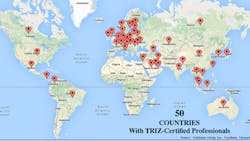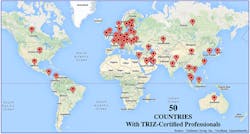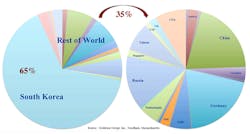Triz is Now Practiced in 50 Countries
This file type includes high resolution graphics and schematics when applicable.
Triz is an innovation technique that professionals systematically apply according to a defined set of principles. Originally developed in Russia by Genrich Altshuller in the 1940s, Triz took a number of years to cross the ocean and become available in English. By the early 1990s, Triz had gained a foothold in the U.S. and slowly began spreading globally from its Russia- and U.S.-based "centers of excellence." Triz is now practiced in at least 50 countries.
History: The brilliance of Triz stems from the origins of its data set. Altshuller analyzed 40,000 registered patents to determine their common inventive principles, and to hopefully observe other systematic attributes of inventions. The short version of his findings were that there were 40 basic inventive principles, 39 common parameters that engineers look to optimize, and 76 standard approaches that engineers and inventors used in their designs. Nonsense, you say? Not so. Sample sizes of up to two million patents were examined by other companies over the years, and they merely tweaked Altshuller's discoveries.
North American Industry Usage: GGI has researched markets and companies where Triz was involved in analytical software since the late 1980s. Our statistically valid primary research in 2008 showed it to be the third most used tool by professionals looking to innovate. Still, it had penetrated only 21% of a cross-industry sample of North American companies. 10% used it limitedly, 10% used it occasionally, and only 1% said it was fully embedded. Adoption of innovation techniques is clearly not as mature as operational excellence techniques such as Six Sigma, lean, and other value-engineering tools. For reference, our research showed that internal knowledge wikis were number two at 38% and the free USPTO web site was first at 53%.
Global Industry Penetration: Last year, a GGI primary research project explored the global penetration of Triz. We got reasonably good data for the period 2007 to 2015, based on the number of Triz-certified professionals we could identify in each country.
In summary, there are 50 countries with Triz-certified professionals. Between 1991 and 2007 when our data set began, 1,400 people had achieved certification. We now count over 18,000. Plus, there are about another 6,000 who chose not to publish their certification. There are now roughly 25,000 people worldwide who are certified Triz practitioners, or are likely practicing at a certified level.
South Korea dominates the global footprint with 65% of all practitioners. Germany and China each have 7%. Russia is next at 5%, followed by the U.S. and Taiwan at 3%. India and the Netherlands each have 2%.
Potential Uses and Benefits: Triz has wide applicability across product creation through commercialization, as well as for developing intellectual property. Right now, less strategic companies use it in late stages of design through cost reduction and value engineering. More strategic companies use it in advanced development and intellectual property development long before detailed design and production. GGI’s research also identified a notable finding: Companies that seriously use Triz actively discourage employees from discussing it outside the company, and rarely present at conferences. Treating Triz a confidential company subject indicates Triz creates a competitive advantage.
Future Growth of Triz: The year-over-year growth rates between 2007 and 2015 are impressive, ranging from 23 to 47% annual growth.
There has also likely been a constraint on growth because there is a shortage of qualified Triz instructors. “Triz Masters” are hard to come by. There are approximately 150 in the world, with 70% in Russia; South Korea and the U.S. equally share the rest. Not all five levels of Triz must be taught by Masters. But, as others have started teaching to service a growing demand, some unevenness of skill sets in the lower two levels of certification have resulted.
When demand exceeds capacity, it is often a sign that a new industry is about to be born.
Looking for parts? Go to SourceESB.
This file type includes high resolution graphics and schematics when applicable.
About the Author
Bradford Goldense
Contributing Technical Expert
Bradford L. Goldense is founder and president of Goldense Group, Inc. [GGI] (www.goldensegroupinc.com), a consulting, market research, and education firm focused on business and technology management strategies and practices for product creation, development, and commercialization. He has been an adjunct faculty member of the graduate engineering school at Tufts University's Gordon Institute for 19 years. Goldense is a Certified New Product Development Professional [NPDP], a Certified Manufacturing Engineer [CMfgE], a Certified Computer Professional [CCP], and is Certified In Production & Inventory Management [CPIM]. He holds over 200 registered copyrights and is a recognized subject-matter expert, including appearances on PBS and CNBC. He has consulted to over 250 companies and over 750 manufacturing locations on four continents since founding GGI in 1986. Goldense holds an MBA in Accounting from the Cornell Johnson School and a BSCE from Brown University. For more information, please see Brad's LinkedIn profile or visit GGI's home page.




